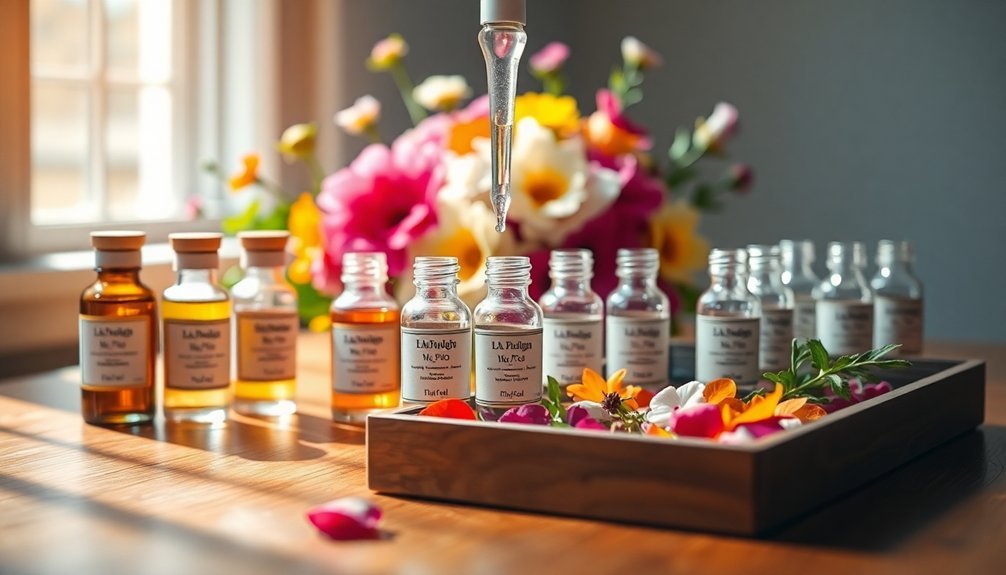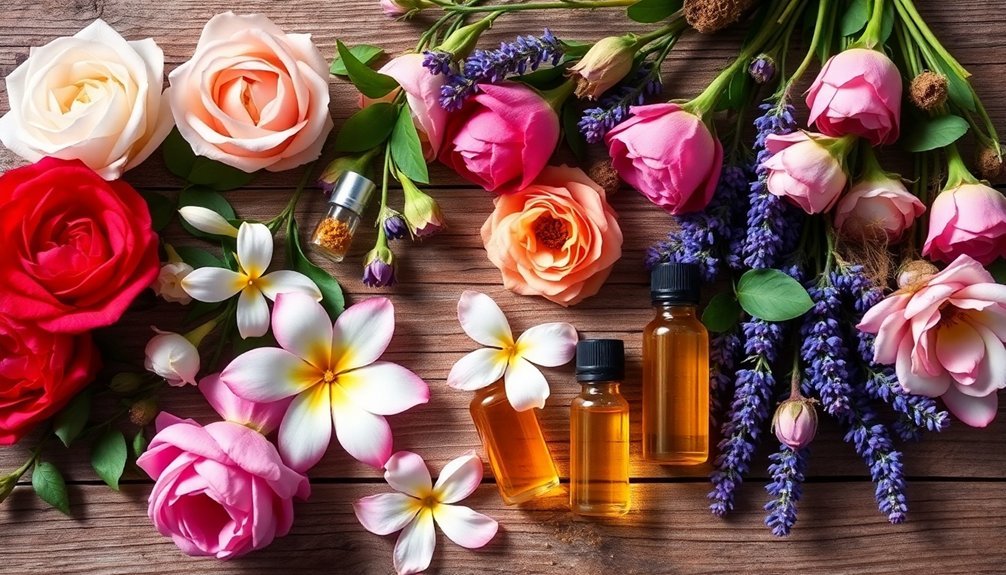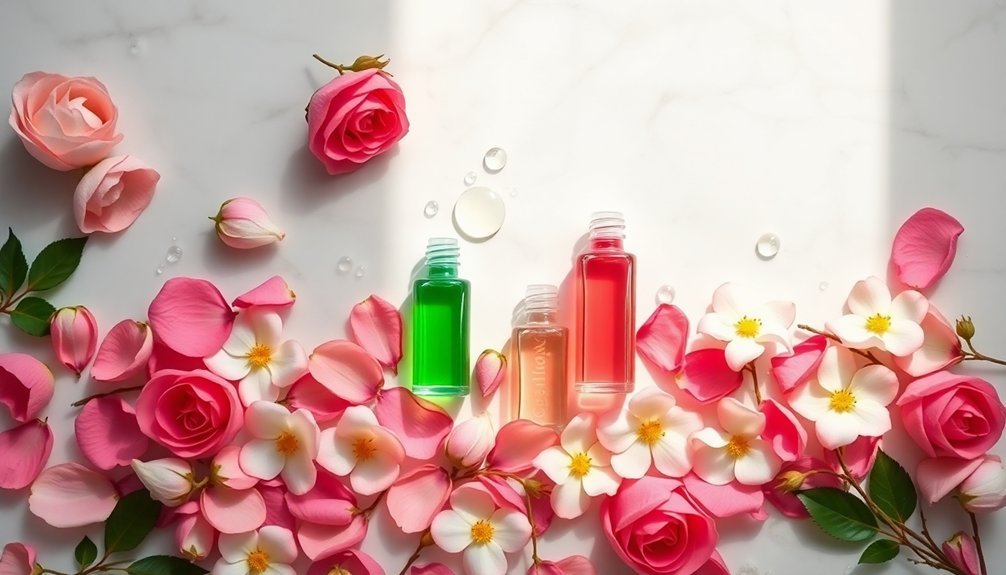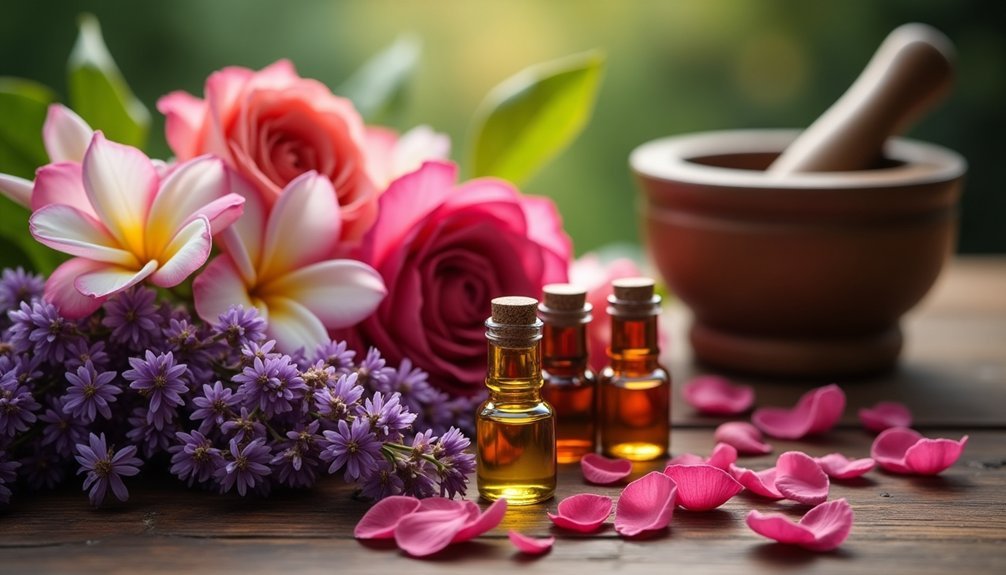To create a timeless floral perfume, you'll need to master four key ingredients: rose, jasmine, lavender, and orchid. Follow the 30/50/20 rule when blending your notes – 30% top notes for initial impact, 50% heart notes for body, and 20% base notes for longevity. Apply to clean, moisturized skin at pulse points, and incorporate natural fixatives like patchouli or vetiver. Understanding proper extraction methods and seasonal variations will reveal your path to crafting the perfect signature scent.
Essential Floral Notes Every Perfumer Must Know

When crafting fine perfumes, understanding the foundational floral notes is essential to creating sophisticated fragrances.
A well-structured blend takes advantage of top, middle, and base notes to create a lasting impression.
You'll want to master four key ingredients that serve as the cornerstone of most floral compositions.
Rose brings depth with its warm, spicy-sweet character and honey undertones, working beautifully as a middle or top note.
Jasmine offers versatility with its rich, unisex appeal and can anchor your blend as either a top or base note.
Lavender's elegant and soothing nature makes it perfect for both middle and top notes.
For base notes, orchid's soft, sweet profile complements vanilla beautifully.
These classic florals form the building blocks of countless successful fragrances, and you'll find them indispensable as you develop your perfumery skills.
Understanding Base, Heart, and Top Note Harmonies
To create a harmonious perfume, you'll need to master the delicate interplay between base, heart, and top notes. Start by allocating the right proportions: 20-40% for top notes, 50-75% for heart notes, and 5-10% for base notes.
Your top notes, like bergamot and lavender, will create the initial impression but fade within 30 minutes. The heart notes provide body and typically last between 1 to 5 hours after application.
Step-by-Step Perfume Layering Technique

Mastering the art of perfume layering begins with a methodical approach to creating depth and complexity in your signature scent.
Start with clean, hydrated skin and apply a scented body wash followed by a matching lotion to establish your foundation. This initial step guarantees your fragrances will blend seamlessly with your natural body chemistry. For optimal results, select oil-based fragrances to maximize the longevity of your layered perfumes.
- Apply your base fragrance to pulse points, selecting a medium-intensity scent that complements floral notes.
- Layer your primary floral perfume directly onto the same spots, allowing it to settle for a few moments.
- Add secondary scents by spraying a few inches away from your skin, focusing on complementary notes.
- Blend the fragrances by gently dabbing your wrists together, then wait for the scents to harmonize.
Remember to adjust your layering technique based on the season and occasion, keeping applications light initially.
Mastering the Art of Floral Note Combinations
When combining floral notes, you'll want to start with complementary flowers that naturally enhance each other, such as pairing rose with jasmine for a rich, harmonious blend.
You can create depth by layering lighter floral notes like lavender or orange blossom with heavier base notes like orchid or ylang-ylang.
For a sophisticated composition, try balancing your floral combinations with woody or spicy accents, as demonstrated in classic perfumes like Chanel's Coco Mademoiselle.
Essential Floral Pairing Rules
Creating perfect floral perfume blends requires a deep understanding of essential pairing rules and scent compatibility.
When combining florals, you'll need to take into account both concentration levels and scent families to achieve a harmonious blend.
- Always match perfume concentrations – if you're working with a strong rose absolute, pair it with similarly concentrated fragrances to maintain balance.
- Follow the 30/50/20 rule for note distribution – use 30% top notes, 50% middle notes, and 20% base notes.
- Pair complementary scent families – combine florals with citrus for freshness or woody notes for depth.
- Choose flowers at peak fragrance and take note of their intensity – strong aromatics like jasmine and gardenia need careful balancing with lighter notes.
Remember to use discovery sets to experiment with different combinations until you find your perfect blend.
Harmonizing Complementary Flower Notes
The art of harmonizing complementary flower notes requires a deep understanding of how different floral elements interact and complement each other. When you're blending floral fragrances, start by identifying your base scent's dominant characteristics, then select complementary notes that enhance its unique qualities. Consider both intensity and seasonal appropriateness when creating your blend.
| Floral Note | Best Complementary Pairing |
|---|---|
| Rose | Jasmine, Violet, Lily |
| Lavender | Bergamot, Vanilla, Geranium |
| Jasmine | Orange Blossom, Ylang-ylang, Rose |
| Lily | Tuberose, Rose, Gardenia |
| Peony | Freesia, Rose, Lily of the Valley |
You'll want to test your combinations on your skin, as body chemistry affects how fragrances develop. Remember to balance strong florals with lighter notes, and don't hesitate to incorporate contrasting elements like woody or citrus notes for added depth.
Natural Fixatives for Long-Lasting Scents

Natural fixatives serve as the foundation for creating long-lasting perfumes, anchoring delicate top notes while ensuring the entire fragrance composition remains stable over time.
You'll find both plant-based and traditional options that can dramatically improve your perfume's longevity and depth.
Here's how to effectively incorporate natural fixatives into your floral blends:
- Start with patchouli or vetiver essential oil as your base – they'll add richness while extending wear time.
- Layer in benzoin or tolu balsam to give your blend more body and slow down essential oil evaporation.
- Add a touch of sandalwood to enhance floral notes while providing luxurious staying power.
- Consider orrisroot for a violet-like powdery effect that helps stabilize the entire composition.
Choose fixatives that complement your floral notes while avoiding animal-derived ingredients for ethical perfumery.
Balancing Sweet and Deep Floral Elements
Successful floral perfumes rely on a delicate interplay between sweet and deep elements to create enchanting, well-rounded fragrances.
Start by selecting deep florals like ylang-ylang or Arabian jasmine for your middle notes, then layer them with delicate top notes of lavender or freesia. You'll want to enhance these florals with sweet elements like vanilla, honey, or tonka bean.
To add depth and longevity, incorporate base notes such as sandalwood or amber. These grounding elements will prevent your blend from becoming overly sweet.
Don't forget to balance your composition with fresh citrus notes like bergamot, or add intrigue with spicy touches of cinnamon.
For a modern twist, you can introduce contrasting elements like leather or aquatic notes, creating a unique signature scent that's both sophisticated and memorable.
Creating Signature Blends With Rose and Jasmine

When crafting signature perfume blends, rose and jasmine stand as pillars of fine fragrance artistry.
You'll want to select Bulgarian or Turkish roses paired with Jasmine Sambac for their rich, distinctive profiles. These precious florals blend beautifully with complementary notes to create a harmonious, evolving scent.
To create your signature blend, follow these essential steps:
- Build your foundation with Tahitian vanilla-infused jojoba oil as a gentle, long-lasting base.
- Layer in frankincense and sandalwood to add depth without overwhelming the florals.
- Crown your creation with bright blood orange top notes for an uplifting introduction.
- Balance the concentration carefully so neither rose nor jasmine dominates.
Use organic ingredients and botanical waxes for a sustainable, skin-friendly formula that'll last throughout the day.
Modern Twists on Traditional Floral Fragrances
While classic rose and jasmine combinations remain timeless, today's perfumers are revolutionizing floral fragrances with bold, unexpected pairings. You'll find traditional florals enhanced with fruity notes like strawberry or layered with gourmand elements such as vanilla and caramel.
These modern interpretations create depth and complexity that wasn't possible before.
To craft your own contemporary floral blend, try incorporating unconventional notes like orange blossom, ylang-ylang, or cyclamen. You can also experiment with innovative ingredients such as NymphealTM for added volume and creaminess.
Balance these elements by carefully layering fresh, green notes with richer base notes, and don't be afraid to use modern aroma chemicals like hedione to enhance the overall composition.
Remember to adjust concentrations gradually until you achieve the perfect harmony between traditional and modern elements.
Seasonal Floral Blend Variations

Mastering seasonal floral blends requires understanding how different notes complement each year's distinct moods and temperatures.
In spring, combine citrus with jasmine and rose for an awakening blend, while summer calls for bright notes like bergamot and solar lily paired with tropical elements.
As autumn arrives, incorporate warming elements like vanilla and sandalwood to ground your florals.
For year-round success with seasonal blends, remember these key principles:
- Adapt intensity – lighter in summer, deeper in autumn
- Match the mood – energizing for spring, relaxing for summer evenings
- Consider temperature – fresh notes cool in summer, spicy notes warm in fall
- Layer strategically – start with base notes appropriate to the season, then build complementary layers
Create your signature seasonal scents by adjusting these elements while maintaining your preferred floral core.
The Secret Behind Timeless Floral Compositions
The timeless appeal of floral compositions stems from masterful extraction methods and precise blending techniques that capture nature's essence. You'll find that the most enduring fragrances combine different extraction methods to preserve each flower's unique characteristics. Steam distillation creates pure essences, while CO2 extraction captures delicate nuances that might otherwise be lost.
| Extraction Method | Best For |
|---|---|
| Steam Distillation | Rose, Lavender |
| Solvent Extraction | Jasmine, Tuberose |
| Enfleurage | Delicate Blooms |
| CO2 Extraction | Complex Notes |
| Cold Pressing | Selected Flowers |
To create a lasting impression, you'll need to focus on proper layering and fixation. Start with complementary base notes like orris root or tonka bean, which will anchor your floral blend. Remember that your body chemistry affects longevity, so apply your perfume to pulse points where it's warmer and well-moisturized.
Frequently Asked Questions
How Can I Test My Perfume's Longevity Before Bottling It?
You'll need to conduct skin tests, use blotter strips, and perform stability testing. Apply your perfume to pulse points, monitor its evolution over hours, and use climate chambers for accelerated aging assessment.
What Materials and Equipment Are Essential for a Beginner Perfume Maker?
You'll need perfumer's alcohol, essential oils, protective gear (gloves, goggles), digital scale, glass beakers, pipettes, and bottles. Don't forget labels and fragrance blotters for testing your creations.
Can Pregnancy or Medications Affect How Floral Perfumes Smell to Individuals?
Yes, your pregnancy can dramatically alter how floral perfumes smell due to heightened sensitivity (hyperosmia). Some medications may also change your perception of fragrances by affecting your body's chemical responses and hormonal balance.
How Should Floral Perfumes Be Properly Stored to Maintain Their Quality?
Store your floral perfumes in a cool, dark cabinet between 15-20°C. You'll want to keep them away from sunlight, bathrooms, and kitchens. Don't forget to tightly seal bottles to prevent fragrance degradation.
What Safety Precautions Should Be Taken When Working With Concentrated Floral Essences?
You'll need to store oils in dark glass bottles, avoid skin contact, use proper dilution, maintain ventilation, and keep them away from children and flames. Always have emergency contacts ready.
In Summary
Creating timeless floral perfumes isn't just about mixing scents – it's about understanding the soul of each note and how they dance together. You'll find success when you've mastered the balance between classic and contemporary elements, natural fixatives, and seasonal adaptations. Remember, your signature blend should tell a story that unfolds gradually, leaving an unforgettable impression that stands the test of time.
References
- https://www.alphaaromatics.com/blog/floral-scents/
- https://basenotes.com/community/threads/lets-talk-methodology-and-your-approach-in-perfume-making.474406/
- https://rosyandearnest.com/blogs/news/floral-perfume
- https://wtf.tw/ref/golombisky.pdf
- https://light4lifecause.com/blogs/blogs/4-timeless-floral-scents
- https://methrashop.co/blogs/news/floral-perfume-exploring-the-most-popular-ingredients
- https://www.youtube.com/watch?v=hmYfoGoSsEk
- https://topmidbase.com/blog/how-to-make-perfume-the-complete-guide/
- https://www.perfumestars.com/perfume-notes/floral-notes/
- https://lebleubodycare.com/blogs/news/understanding-the-layers-top-heart-and-base-notes-in-fragrance
- https://www.houseofmarste.com/blogs/news/understanding-fragrance-notes-top-middle-and-base-explained
- https://www.charlottetilbury.com/us/secrets/what-are-top-heart-base-fragrance-notes
- https://www.edensgarden.com/blogs/news/understanding-top-middle-and-base-notes-in-perfume
- https://us.shayandblue.com/blogs/journal/top-heart-base-what-does-it-all-mean
- https://theduabrand.com/blogs/dua-usa/fragrance-layering-101-how-to-create-your-own-signature-scent
- https://www.youtube.com/watch?v=L8-cF2rg02g
- https://kannaujheaven.com/blogs/news/mastering-the-art-of-fragrance-layering-how-to-mix-and-match-great-womens-perfumes
- https://us.clivechristian.com/blogs/perfume-facts/how-to-layer-perfume
- https://storiesparfums.com/en-de/blogs/news/beginners-guide-to-fragrance-chapter-5-how-to-layer-fragrance
- https://suephillips.com/collections/floral-perfume-blends





Leave a Reply